不定式的用法总结
不定式用法总结

hope, demand, suggest等动词不能后接 动词不定式作宾补。 ①I hope my son will be back soon. ②She advises us to have a discussion about it. ③She suggests that we (should) have a discussion about it.
5.定语
定式与被修饰的名词往往构成逻辑上的关系。如名词 为不定式的逻辑主语,构成主谓关系; 若名词为逻辑宾语, 则构成动宾关系; He is not the first employee to arrive at the office this morning. There will not be enough space to stand in on the earth I have some books for you to read. 2、作定语的不定式与所修饰的名词之间是动宾关系, 不定 式动词又是不及物动词时,应在该动词上加上一个介词,如; He has a nice pen to write with. He is looking for a room to live in. He is said the best way to travel by is on foot.
动词不定式的基本用法归纳
一、动词不定时的形式: 肯定式:to do sth 否定式:not to do sth. 被动式:to be done 一般被动否定式:not to be done 完成主动式:to have done 完成否定式: not to have done 完成被动式:to have been done 完成被动否定式: not to have been done
不定式的六种用法
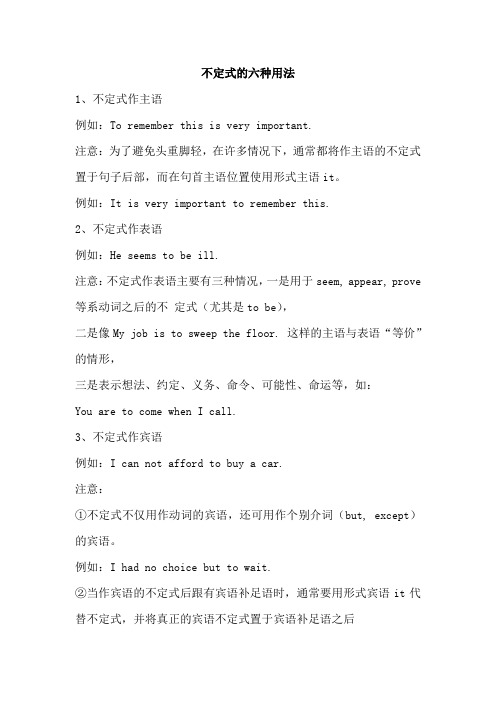
不定式的六种用法1、不定式作主语例如:To remember this is very important.注意:为了避免头重脚轻,在许多情况下,通常都将作主语的不定式置于句子后部,而在句首主语位置使用形式主语it。
例如:It is very important to remember this.2、不定式作表语例如:He seems to be ill.注意:不定式作表语主要有三种情况,一是用于seem, appear, prove 等系动词之后的不定式(尤其是to be),二是像My job is to sweep the floor. 这样的主语与表语“等价”的情形,三是表示想法、约定、义务、命令、可能性、命运等,如:You are to come when I call.3、不定式作宾语例如:I can not afford to buy a car.注意:①不定式不仅用作动词的宾语,还可用作个别介词(but, except)的宾语。
例如:I had no choice but to wait.②当作宾语的不定式后跟有宾语补足语时,通常要用形式宾语it代替不定式,并将真正的宾语不定式置于宾语补足语之后例如:I find it difficult to learn Japanese well.4、不定式作宾语补足语例如:Who taught you to drive?5、不定式作定语例如:I have a question to ask you.注意:有的名词(如way, chance, right等)后用作不定式可换成of doing sth.如:It is the best way to do (of doing) it.但是以下名词后接不定式作定语时通常不能换成of doing sth. attempt courage decision effort fortune failure invitation wish6、不定式作状语例如:I went to France to learn French.。
非谓语动词(不定式)的用法
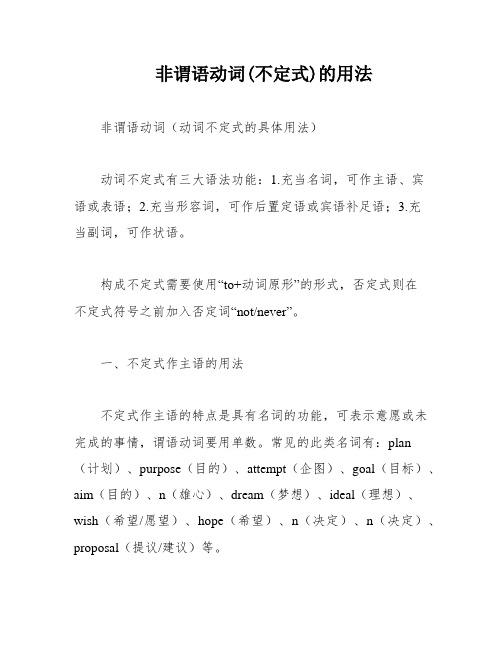
非谓语动词(不定式)的用法非谓语动词(动词不定式的具体用法)动词不定式有三大语法功能:1.充当名词,可作主语、宾语或表语;2.充当形容词,可作后置定语或宾语补足语;3.充当副词,可作状语。
构成不定式需要使用“to+动词原形”的形式,否定式则在不定式符号之前加入否定词“not/never”。
一、不定式作主语的用法不定式作主语的特点是具有名词的功能,可表示意愿或未完成的事情,谓语动词要用单数。
常见的此类名词有:plan(计划)、purpose(目的)、attempt(企图)、goal(目标)、aim(目的)、n(雄心)、dream(梦想)、ideal(理想)、wish(希望/愿望)、hope(希望)、n(决定)、n(决定)、proposal(提议/建议)等。
为了避免主语过长,不定式短语可放在句末,用形式主语“it”代替原来的主语位置,不定式则成为真正的主语。
例如:___.(赢得冠军是我的雄心。
)To master a foreign language is necessary.(掌握一门外语是有必要的。
)To e President of the United States used to be my goal.(过去我的梦想是成为美国总统。
)Speaking perfect English is always my dream.(说一口流利的英语一直是我的梦想。
)It is ___.(保护环境是有必要的。
)There are two special ___:1) It is + adj + of sb + to do sth.2) It is + adj + for sb + to do sth.___ characteristics and differences are:1) If ___ characteristics or traits。
the logical subject of the ___ "of."Examples:It is very affable of you to help me。
动词不定式的用法总结及例句
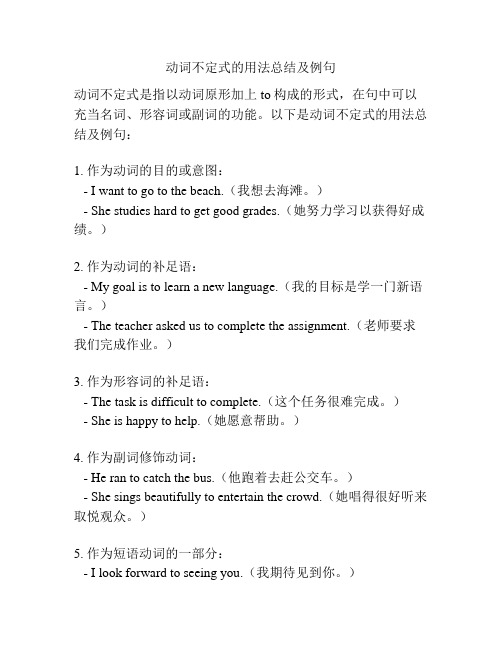
动词不定式的用法总结及例句动词不定式是指以动词原形加上to构成的形式,在句中可以充当名词、形容词或副词的功能。
以下是动词不定式的用法总结及例句:1. 作为动词的目的或意图:- I want to go to the beach.(我想去海滩。
)- She studies hard to get good grades.(她努力学习以获得好成绩。
)2. 作为动词的补足语:- My goal is to learn a new language.(我的目标是学一门新语言。
)- The teacher asked us to complete the assignment.(老师要求我们完成作业。
)3. 作为形容词的补足语:- The task is difficult to complete.(这个任务很难完成。
)- She is happy to help.(她愿意帮助。
)4. 作为副词修饰动词:- He ran to catch the bus.(他跑着去赶公交车。
)- She sings beautifully to entertain the crowd.(她唱得很好听来取悦观众。
)5. 作为短语动词的一部分:- I look forward to seeing you.(我期待见到你。
)- He decided to give up smoking.(他决定戒烟。
)6. 作为动词的主语:- To live a healthy lifestyle is important.(过健康的生活方式很重要。
)- To travel the world is his dream.(环游世界是他的梦想。
)7. 作为动词的宾语:- I like to read novels.(我喜欢读小说。
)- They want to visit their grandparents.(他们想去拜访祖父母。
)需要注意的是,动词不定式在句中的位置可以灵活变化,但通常放在动词之后、名词之前、或者作为句子的结尾。
不定式用法初中不定式的常见用法总结
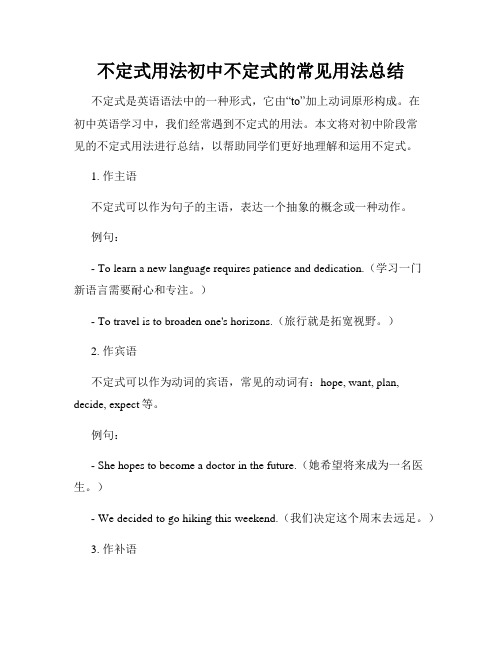
不定式用法初中不定式的常见用法总结不定式是英语语法中的一种形式,它由“to”加上动词原形构成。
在初中英语学习中,我们经常遇到不定式的用法。
本文将对初中阶段常见的不定式用法进行总结,以帮助同学们更好地理解和运用不定式。
1. 作主语不定式可以作为句子的主语,表达一个抽象的概念或一种动作。
例句:- To learn a new language requires patience and dedication.(学习一门新语言需要耐心和专注。
)- To travel is to broaden one's horizons.(旅行就是拓宽视野。
)2. 作宾语不定式可以作为动词的宾语,常见的动词有:hope, want, plan, decide, expect等。
例句:- She hopes to become a doctor in the future.(她希望将来成为一名医生。
)- We decided to go hiking this weekend.(我们决定这个周末去远足。
)3. 作补语不定式可以作为某些动词的补语,用于补充说明主语的身份、性质、状态等。
例句:- Her dream is to become a famous singer.(她的梦想是成为一位著名的歌手。
)- I am happy to help you with your homework.(我很高兴帮你做功课。
)4. 作定语不定式可以修饰名词,用于进一步说明名词的用途、目的等。
例句:- I need a book to study for the exam.(我需要一本书来复习考试。
)- Do you have a pen to borrow?(你有一支能借给我用的笔吗?)5. 作状语不定式可以作为状语,用于修饰动词、形容词等,表达动作的目的、结果、原因等。
例句:- He ran to catch the bus.(他跑去赶公交车。
(完整版)动词不定式的用法总结

动词不定式的用法总结动词不定式在中学英语中应用非常广泛,一方面在句中可起名词、形容词或副词的作用,同时也可在句中作主语、宾语、定语、状语和宾语补足语。
接下来为大家提供了以下:动词不定式的用法总结一动词不定式的形式一般是to +动词原形,但to有时要省去。
而动词不定式在具体运用时用不用to,取决于谓语动词的用法。
现就以下几方面介绍如下。
一、不定式结构1. 带to的不定式结构能直接跟带to的不定式结构的动词主要有:want, ask, tell, hope, learn, try, decide, forget, remember, like, love, stop, go, come等。
如:I want to go to the movies with you.我想跟你一起去看电影。
Don’t forget to turn off the light before you leave.在你离开之前别忘了关灯。
注意:动词不定式的否定形式是在不定式前直接加not,即not to do sth.。
如:Dave told me not to wake up Kate.大卫告诉我别叫醒凯特。
2. 不带to的不定式结构以下几种情况使用不带to的动词不定式:(1)在固定词组had better之后。
注意:had better的否定形式是had better not do sth.。
如:You had better go home now.你最好现在回家。
It’s cold outside. You’d better not go out.外面很冷,你最好不要出去。
(2)在let, make, see, feel, watch, hear等感官或使役动词后,要跟不带to的动词不定式作宾语补足语。
如:I made them give me the money back.我迫使他们把钱还给我。
I didn’t see you come in.我没看见你进来。
初中语法实用技巧不定式的用法总结

初中语法实用技巧不定式的用法总结不定式是英语中具有动词功能的非谓语形式,用来表示目的、意图、目标等含义。
在初中英语中,不定式的用法很常见。
本文将总结初中语法中不定式的使用技巧,以帮助初中学生学习和运用不定式。
一、不定式作主语不定式可以作为句子的主语,一般位于句尾。
例如:To learn English well is my goal.(学好英语是我的目标。
)二、不定式作宾语不定式可以作为动词的宾语,常跟在动词后面。
例如:I want to watch a movie tonight.(我今晚想看电影。
)三、不定式作定语不定式可以修饰名词或代词,作为定语放在其前面。
例如:I have a book to read.(我有一本要读的书。
)四、不定式作表语不定式可以作为动词be的表语,说明主语的身份或状态。
例如:His dream is to be a doctor.(他的梦想是当一名医生。
)五、不定式作宾补不定式可以作为某些动词的宾语补足语,用来补充说明动作的目的或结果。
例如:She made me laugh.(她逗我笑。
)六、介词+不定式介词+不定式结构常用来表示目的、原因、方式等。
例如:He went to the park to play basketball.(他去公园打篮球。
)七、情态动词+不定式情态动词后面接不定式,用来表示情态的不同。
例如:We should study hard.(我们应该努力学习。
)八、不定式的完成形式不定式也有完成式,即“to have + 过去分词”。
常用于表示发生在不定式动作之前的动作。
例如:We are glad to have finished the project.(我们很高兴已经完成了这个项目。
)九、带有被动语态的不定式不定式也可以带有被动语态,即“to be + 过去分词”。
例如:I hope to be invited to the party.(我希望被邀请参加派对。
不定式的用法总结

My brother asked me to clean the room
with him.
常带 to 的不定式做宾语补足语的动词有: ask, beg, prefer, help, promise, wish, want, expect, permit, request, allow, command,
• You must remember to lock the door when you leave
• • • • • • • • • •
2. remember doing sth 记得曾做过某事 I remember locking the front door 3. forget to do sth 忘记要做某事 He forgot to do his homework yesterday 4. forget doing sth 忘记曾做过某事 I forgot saying this thing to you 5. try to do sth 努力做某事 He tries to answer each question 6. try doing sth 试着做某事 I tried singing an English song
doing指经常性动作,而 to do指一次性的动作。 I like swimming,but I don‘t like to swim now. 我喜欢游泳, 但我现在不想游。 begin\start to do sth begin\start doing sth
提示板:
• 后面只接动名词做宾的动词
巧记动词不定式作宾语歌诀:
•
• • • • • • •
想要拒绝莫忘记 (want, refuse, forget) 需要努力就学习 (need, try, learn) 喜欢帮助加同意 (like help agree ) 希望决定后开始 (hope, decide, begin, start)
动词不定式6种用法
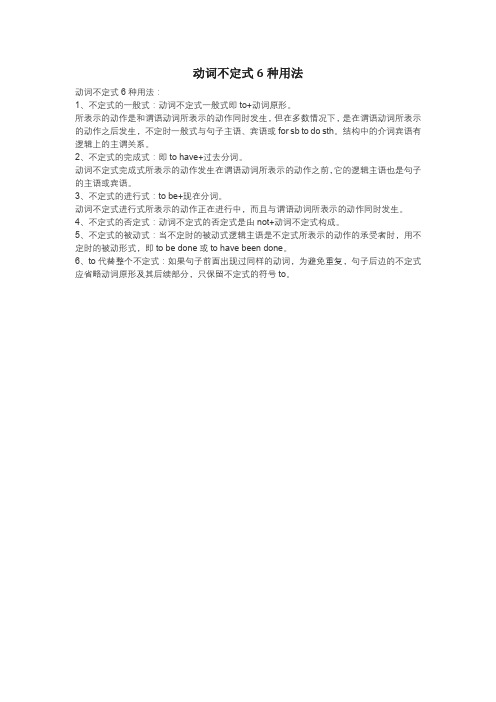
动词不定式6种用法
动词不定式6种用法:
1、不定式的一般式:动词不定式一般式即to+动词原形。
所表示的动作是和谓语动词所表示的动作同时发生,但在多数情况下,是在谓语动词所表示的动作之后发生,不定时一般式与句子主语、宾语或for sb to do sth。
结构中的介词宾语有逻辑上的主谓关系。
2、不定式的完成式:即to have+过去分词。
动词不定式完成式所表示的动作发生在谓语动词所表示的动作之前,它的逻辑主语也是句子的主语或宾语。
3、不定式的进行式:to be+现在分词。
动词不定式进行式所表示的动作正在进行中,而且与谓语动词所表示的动作同时发生。
4、不定式的否定式:动词不定式的否定式是由not+动词不定式构成。
5、不定式的被动式:当不定时的被动式逻辑主语是不定式所表示的动作的承受者时,用不定时的被动形式,即to be done或to have been done。
6、to代替整个不定式:如果句子前面出现过同样的动词,为避免重复,句子后边的不定式应省略动词原形及其后续部分,只保留不定式的符号to。
不定式的用法
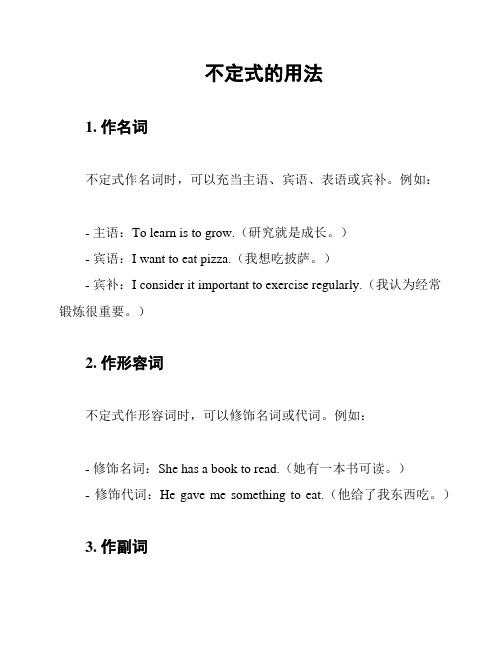
不定式的用法1. 作名词不定式作名词时,可以充当主语、宾语、表语或宾补。
例如:- 主语:To learn is to grow.(研究就是成长。
)- 宾语:I want to eat pizza.(我想吃披萨。
)- 宾补:I consider it important to exercise regularly.(我认为经常锻炼很重要。
)2. 作形容词不定式作形容词时,可以修饰名词或代词。
例如:- 修饰名词:She has a book to read.(她有一本书可读。
)- 修饰代词:He gave me something to eat.(他给了我东西吃。
)3. 作副词不定式作副词时,可以修饰动词、形容词或副词。
例如:- 修饰动词:She studied hard to pass the exam.(她努力研究以通过考试。
)- 修饰形容词:He is too young to understand.(他太年轻,无法理解。
)- 修饰副词:She runs fast to catch the bus.(她跑得快来赶公交车。
)4. 其他用法除了上述用法外,不定式还有一些其他的用法:- 表示目的:I went to the store to buy some milk.(我去商店买牛奶。
)- 用于情态动词后:He should go to bed early.(他应该早点上床睡觉。
)- 用于与其他动词连用:He hopes to find a job soon.(他希望尽快找到一份工作。
)不定式的用法多种多样,需要根据具体的语境和句子结构来判断。
掌握不定式的用法能够帮助我们更准确地理解和表达语言中的意思。
不定式的用法及归纳
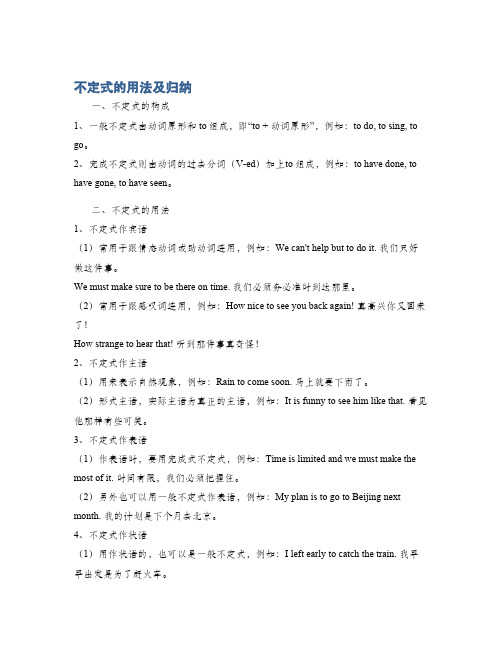
不定式的用法及归纳一、不定式的构成1、一般不定式由动词原形和to组成,即“to + 动词原形”,例如:to do, to sing, to go。
2、完成不定式则由动词的过去分词(V-ed)加上to组成,例如:to have done, to have gone, to have seen。
二、不定式的用法1、不定式作宾语(1)常用于跟情态动词或助动词连用,例如:We can't help but to do it. 我们只好做这件事。
We must make sure to be there on time. 我们必须务必准时到达那里。
(2)常用于跟感叹词连用,例如:How nice to see you back again! 真高兴你又回来了!How strange to hear that! 听到那件事真奇怪!2、不定式作主语(1)用来表示自然现象,例如:Rain to come soon. 马上就要下雨了。
(2)形式主语,实际主语为真正的主语,例如:It is funny to see him like that. 看见他那样有些可笑。
3、不定式作表语(1)作表语时,要用完成式不定式,例如:Time is limited and we must make the most of it. 时间有限,我们必须把握住。
(2)另外也可以用一般不定式作表语,例如:My plan is to go to Beijing next month. 我的计划是下个月去北京。
4、不定式作状语(1)用作状语的,也可以是一般不定式,例如:I left early to catch the train. 我早早出发是为了赶火车。
(2)另外,也有完成不定式用作状语,使句子更加丰满,例如:She looked around, having entered the room. 她走进房间后,四下张望。
动词不定式的用法

动词不定式的用法动词不定式由to+动词原形构成。
这里的to是不定式标志,没有词义。
一、各种形式1. 基本形式:to+动词原形2. 否定形式:not to donever to do二、用法(一)作主语(谓语动词常用单数)1. 位于句首To keep a pet is interesting.养宠物时间有趣的事。
To get up early is a good habit.早起是个好习惯。
2. 位于句末⑴It's+adj./n.+todo sth.It's easy to make friends with him.和他交朋友很容易。
It's interesting to play games with kids.和孩子们玩游戏很有趣。
It's my dream to be a pilot.成为飞行员是我的梦想。
⑵It's+adj.+for sb.+to do sth.It's not easy for me to make friends.对我来说,交朋友不太容易。
It's possible for humans to fly to the moon.对于人类而言,飞上月球是可能的。
⑶It's+adj.+of sb.+todo sth.=sb.+be+adj.+to do sth.It's very kind of you to help us.=You are kind to help us.小结训练1. It's our duty _________ the room every day.A. to cleanB. cleanedC. cleanD. cleans(甘肃省)2. It's hard for us _________ English well.A. learnB. learnsC. to learnD. learning(江西省)3.建造这座立交桥将花费工人们一年多的时间。
动词不定式的用法小结

动词不定式的用法小结动词不定式是英语语法中的一个重要部分,它具有多种用法,灵活多样。
接下来,让我们详细了解一下动词不定式的常见用法。
一、作主语动词不定式作主语时,通常表示具体的、一次性的或将来的动作。
例如:“To learn a foreign language well is not easy”(学好一门外语不容易。
)此时,为了避免句子头重脚轻,常用 it 作形式主语,而将真正的主语动词不定式后置,如:“It is not easy to learn a foreign language well”二、作宾语1、有些动词后只能接动词不定式作宾语,常见的这类动词有:agree(同意),decide(决定),hope(希望),manage(设法),pretend(假装),plan(计划),want(想要),wish(希望)等。
例如:“I decided to go shopping this afternoon”(我决定今天下午去购物。
)2、动词+疑问词+动词不定式。
常见的动词有:know(知道),learn(学习),show(展示),wonder(想知道),understand(理解)等。
例如:“I don't know what to do next”(我不知道接下来做什么。
)三、作宾语补足语1、一些动词如 ask(要求),tell(告诉),want(想要),wish (希望),teach(教),allow(允许)等后面常接带 to 的动词不定式作宾语补足语。
例如:“My mother asks me to clean my room every day”(我妈妈要求我每天打扫房间。
)2、使役动词 let(让),make(使),have(使,让)以及感官动词 see(看见),hear(听见),feel(感觉),watch(观看),notice (注意)等后面接不带 to 的动词不定式作宾语补足语。
不定式的用法总结

真正的宾语是后面的动词不定式。
I found it very difficult to get a job. (it为形式宾语)
如:
The man downstairs found it difficult to get to sleep.
I want to go home. The workers demanded to get better pay. I found it necessary to talk to him again.
think/consider/feel/find it + adj.+ to do
点击规律:在find \ feel \ think\ consider + it
1) 不定式有时和连接代词/副词构成宾语。
你记得哪一条路到那儿吗? Do you remember which way to get there? 下一步干什么你决定了吗? Have you decided what to do next? 我来问他怎么样开这机器。 I’ll ask him how to operate the machine.
5. 作定语 不定式放在被修饰的名词、代词后面,往往 表示未发生的动作。 I have a lot of work to do. She is the first student to come to school. I have some books for you to read. She is looking for a room to live in. There is nothing to worry about.
初中英语不定式用法总结

初中英语不定式用法总结1.不定式的构成不定式的基本形式为:to+动词原形,有时可以不用to,这里的to是不定式符号,本身无词义,动词不定式的否定形式是“not + (to+)动词原形”。
2.不定式的功能(1)不定式作主语动词不定式作主语时,常用it作形式主语,而将真正的主语后置。
如:To learn English well is useful.=It is useful to learn English well.It's important for us to protect the environment.(2)不定式作宾语①不定式用在及物动词后作宾语,常见的及物动同有:begin,choose,continue,decide,expect,fail,forget,hate,help,hope,learn,manage,mean,need,offer,plan,prefer,pretend,promise,refuse,try,want,wish,determine,afford,agree,start,likeShe promised to come at nine o'clock. 她答应九点来的。
I have decided to study English.我已决定学英语了②在find,think后跟不定式作宾语时,常用it代替,而将真正的宾语放在后面。
如:I find it very easy to read English every day.我认为每天读英语很简单。
③常见的一些接不带to的动词不定式的结构Why not do...,Why don't you do...,had better ( not) do...Would rather do,Could/Would/Will you please ( not) do...如:I would rather stay in the room.我宁愿待在房间里。
不定式动词的用法
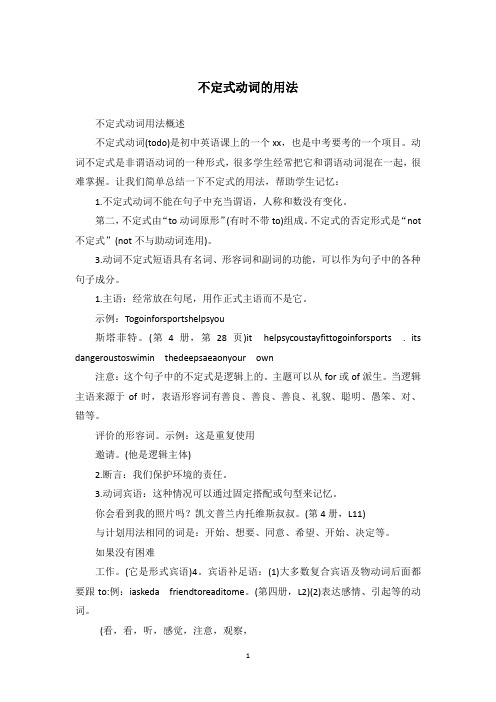
不定式动词的用法不定式动词用法概述不定式动词(todo)是初中英语课上的一个xx,也是中考要考的一个项目。
动词不定式是非谓语动词的一种形式,很多学生经常把它和谓语动词混在一起,很难掌握。
让我们简单总结一下不定式的用法,帮助学生记忆:1.不定式动词不能在句子中充当谓语,人称和数没有变化。
第二,不定式由“to动词原形”(有时不带to)组成。
不定式的否定形式是“not 不定式”(not不与助动词连用)。
3.动词不定式短语具有名词、形容词和副词的功能,可以作为句子中的各种句子成分。
1.主语:经常放在句尾,用作正式主语而不是它。
示例:Togoinforsportshelpsyou斯塔菲特。
(第4册,第28页)it helpsycoustayfittogoinforsports . its dangeroustoswimin thedeepsaeaonyour own注意:这个句子中的不定式是逻辑上的。
主题可以从for或of派生。
当逻辑主语来源于of时,表语形容词有善良、善良、善良、礼貌、聪明、愚笨、对、错等。
评价的形容词。
示例:这是重复使用邀请。
(他是逻辑主体)2.断言:我们保护环境的责任。
3.动词宾语:这种情况可以通过固定搭配或句型来记忆。
你会看到我的照片吗?凯文普兰内托维斯叔叔。
(第4册,L11)与计划用法相同的词是:开始、想要、同意、希望、开始、决定等。
如果没有困难工作。
(它是形式宾语)4。
宾语补足语:(1)大多数复合宾语及物动词后面都要跟to:例:iaskeda friendtoreaditome。
(第四册,L2)(2)表达感情、引起等的动词。
(看,看,听,感觉,注意,观察,制造、让、有、帮助等。
)而不用去。
例如:他们在培训中听到了一个问题。
5.定语:动词的不定式用作定语,放在它修饰的名词后面。
例如:vinnisisfersdisableper-sonto sailaroughwhold。
(第四册,英语)6。
动词不定式用法总结
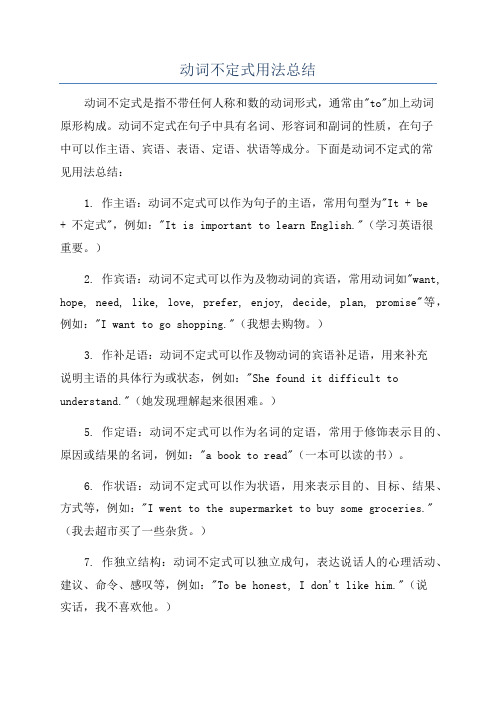
动词不定式用法总结动词不定式是指不带任何人称和数的动词形式,通常由"to"加上动词原形构成。
动词不定式在句子中具有名词、形容词和副词的性质,在句子中可以作主语、宾语、表语、定语、状语等成分。
下面是动词不定式的常见用法总结:1. 作主语:动词不定式可以作为句子的主语,常用句型为"It + be+ 不定式",例如:"It is important to learn English."(学习英语很重要。
)2. 作宾语:动词不定式可以作为及物动词的宾语,常用动词如"want, hope, need, like, love, prefer, enjoy, decide, plan, promise"等,例如:"I want to go shopping."(我想去购物。
)3. 作补足语:动词不定式可以作及物动词的宾语补足语,用来补充说明主语的具体行为或状态,例如:"She found it difficult to understand."(她发现理解起来很困难。
)5. 作定语:动词不定式可以作为名词的定语,常用于修饰表示目的、原因或结果的名词,例如:"a book to read"(一本可以读的书)。
6. 作状语:动词不定式可以作为状语,用来表示目的、目标、结果、方式等,例如:"I went to the supermarket to buy some groceries."(我去超市买了一些杂货。
)7. 作独立结构:动词不定式可以独立成句,表达说话人的心理活动、建议、命令、感叹等,例如:"To be honest, I don't like him."(说实话,我不喜欢他。
)需要注意的是,动词不定式在一些情况下可能没有to的形式出现,例如在情态动词后面、在make, let, help等使役动词后面,或在感官动词如"hear, see, watch"等后面。
不定式的用法

不定式由“to + 动词原形”构成,其否定形式是“not to + 动词原形”。
不定式可以带宾语或状语构成不定式短语,没有人称和数的变化,但有时态和语态的变化。
不定式可作主语、宾语、状语、表语和定语,但不能单独作谓语。
不定式的逻辑主语有时有“for + 名词或代词宾格”构成。
1.不定式的用法1)作主语。
不定式短语作主语时,往往放在谓语之后,用it作形式宾语。
如:To see is to believe.It is right to give up smoking.2)作宾语。
不定式短语作宾语时,如果还带有宾语补足语,往往把不定式宾语放在宾语补足语之后,而用it作形式宾语。
如:He wanted to go.I find it interesting to study history.有些动词后只能用动词不定式作宾语,必须跟不定式。
如:decide,plan,desire,expect,hope,? wish,pretend,promise,refuse,afford,agree,ask,fail,tend,pretend,manage3)作宾语补足语。
如:He asked me to do the work with him.注意:在feel,hear,notice,observe,see,watch,have,let,make等词后的补足语中,不定式不带to。
但这些句子如果变成被动结构时,就必须带to。
如:I often hear him sing the song.He is often heard to sing the song.注意:动词不定式在介词but后面时,如果介词之前有行为动词do的各种形式,那么,这些介词后的不定式不带to,否则要带to。
另外,在can’t choose but 和can’t help but等后面的不定式也省略to。
如:She could do nothing but cry.I have no choice but to go.4)作定语。
- 1、下载文档前请自行甄别文档内容的完整性,平台不提供额外的编辑、内容补充、找答案等附加服务。
- 2、"仅部分预览"的文档,不可在线预览部分如存在完整性等问题,可反馈申请退款(可完整预览的文档不适用该条件!)。
- 3、如文档侵犯您的权益,请联系客服反馈,我们会尽快为您处理(人工客服工作时间:9:00-18:30)。
3) feel, find, make, think, believe, consider 等动词后如果是 不定式做宾语,补语是形容词(或是名词),常用it作形式宾 语,把真正宾语置于补语之后,以免宾语太长使句子显得不 协调。把真正的宾语即不定式后移。
三. 不定式的时态: 1.一般时表示的动作, 有时与谓语动词表示的
动作同时发生, 有时发生在谓语动词表示的 动作之后。 He seems to know this.他似乎知道这事。 I hope to see you again. 我希望再见到你。 2. 完成时表示的动作发生在谓语动词表示的 动作之前。 很抱歉给了你这么多麻烦。
The policeman saw a child play in the street. Don’t make the children do such heavy work. Shall I have him come here? 但是, 改为被动结构后, 应补出省略的to。
The policeman saw a child play in the street. A child was seen to play in the street by the policeman.
4. 作表语 不定式可用作表语,说明主语的具体内容(具体动作或将来动作); 动名词作表语表示抽象的一般行为。 他的梦想是成为一名医生。 His dream is to be a doctor. 我的工作是帮助病人。 My job is to help the patient
5. 作定语 不定式放在被修饰的名词、代词后面,往往 表示未发生的动作。 I have a lot of work to do. She is the first student to come to school. I have some books for you to read. She is looking for a room to live in. There is nothing to worry about.
(4) 被动式(to be done 或者 to have been done)
—表示与逻辑主语之间的被动关系。
不定式的语态
主动式
被动式
一般式
to do
to be done
完成式
to have done
to have been done
进行式
to be doing
间: 看不定式动作与谓 语动词发生的先后 关系
不 定 式
PART 1
定义
定义
不定式是动词的一种非限定形式,由“to+动词原形” 构成,没有人称和数的变化,在句子中不能作谓 语,在句中可以充当任何成分,可以作主语、宾
语、宾语补足语、表语、定语、状语等。
PART 1
不定式在句中的功能
1. 作主语:
不定式在句中的功能
动词不定式作主语时,句子的谓语动词常用单数
1)不定式置于句首。
眼见为实. To see is to believe.
2)为避免句子出现 “头重脚轻”现象,常用it
做形式主语,将真正主语的不定式后置。
要学好英语不是那么容易的。
e.g. It is not easy to learn English well.
2. 作宾语 用作宾语。不定式用作宾语时相当于名词,放在某些动词之后。 这类及物动词常见的有:afford(付得起),agree(同意),attempt (试图),decide(决定),expect(期待),volunteer(自愿做), promise(答应),plan(计划),want(想要) 等。 她喜欢谈论这件事情。 She loves to talk about the matter. 他答应不把这事告诉任何人。 He promised not to tell anyone about it.
• 9. stop to do sth 停下来去做另一件事 • Stop to have a rest if you are tired • 10. stop doing sth 停止做某事 • Although it rained heavily , the farmers didn’t stop working in the field 虽然雨下
I’m sorry to have given you so much trouble.
3. 一般进行时表示的动作正在进行, 与谓语 动词表示的动作同时发生。 他好象正在吃什么东西。 He seems to be eating something.
4. 完成进行时表示的动作从过去开始并延续 至说话的时候。 据说她研究这问题有好多年了。 She is said to have been working on the problem for many years.
• 7. mean to do sth 打算做某事 • We mean to travel abroad next year
• 我们明年打算去国外旅行
• 8. mean doing sth 意味着 • It means waiting for him another hour
• 这意味着要再等一个小时
3)在主动结构中, 下列使役动词和感观动词后,作宾补的 动词不定式应省略to: “五看”(see, watch, notice, observe, look at) “三使”(make, let, have) “两听”(hear, listen to) “一感觉”(feel)。 e.g. Who made him work all night long?
I find it difficult to work with him.
think/consider/feel/find it + adj.+ to do
3. 作宾语补足语:
此时相当于名词,跟在某些及物动词的宾语之后,对宾语作 进一步的补充说明,并与该宾语构成逻辑上的主谓关系。 这类及物动词常见的有advice, allow, ask, consider, encourage等
1) 不定式有时可以带上疑问词how,where,who,when,which, why, what等一起构成不定式短语作宾语。
你记得哪一条路到那儿吗?Do you remember which way to get there? 下一步干什么你决定了吗? Have you decided what to do next? 我来问他怎么样开这机器。I’ll ask him how to operate the machine.
得很大,农民们却没有停止在田间劳动
• 11. regret to do sth 对现在发生的事表示“遗憾” • We regret to inform you that you owe the bank $ 100 • 我们很遗憾地通知你,你欠银行100美元 • 12. regret doing sth 对发生过的事表示“后悔” • He regretted playing computer games.他后悔玩电脑游戏 • 13. go on to do sth • 做完一件事后继续做另外一件不同的事 • 14. go on doing sth继续做原来所做的同一件事
6. 作状语 目的状语: 常用的结构—to do; in order to do, so as to do, so/ such …as to do, etc. I come here to say good-bye to you. 结果状语: 常与only , enough 或too连用。 He studied hard only to fail the exam. He is old enough to go to school.
They pretended to be studying when the teacher came in.
(3) 完成式(to have done 或者 to have been done)
—强调发生在主动词之前。
I’m sorry to have kept you waiting. He is said to have been killed by a thief.
原因状语: 一般用在句尾 I’m glad to see you. She wept to see the sight.
二. 不定式的否定结构: 不定式的否定结构多由“not +不定式”构成, 否定副词 not, never, seldom, hardly 等要置于 to前。 请告诉你的小孩不要在街上玩耍。 Please tell your child not to play in the street. 她检查名字为了不犯错误。 She checked the names so as not to make mistakes.
不定式的时态
(1)一般式(to do 或者 to be done)--在主动词发生同时或之后。 I want to have a holiday as soon as possible . I want to be informed of everything about my son.
(2) 进行式(to be doing) – 强调同时发生并正在进行。
判断语态: 看不定式动作与逻辑主语的关系
2. Rewrite the sentences using infinitive structures
Checking your answers: 1. It is dangerous to be traveling during a sandstorm. 2. Experts hope to learn more about the movement of thunderstorms. 3. We were told not to leave the house. 4. The work on the house needs to be completed (the work) by the end of
